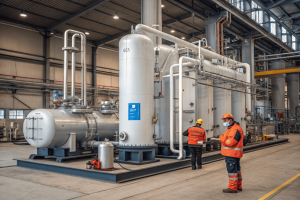What Makes the PSA Process Effective for CO₂ Separation?
•
What Makes the PSA Process Effective for CO₂ Separation?
Are you trying to purify a CO2-rich gas stream? Traditional methods like chemical scrubbing can be complex and energy-intensive, leaving you searching for a more streamlined, cost-effective solution.
Pressure Swing Adsorption (PSA) separates CO2 by using a special solid material, an adsorbent, that traps CO2 molecules on its surface at high pressure. When the pressure is lowered, or "swung," the adsorbent releases the captured CO2, resulting in a purified gas stream.

As an engineer, I appreciate the simple elegance of PSA technology. It leverages basic physical principles to achieve a very precise separation. I've seen it deliver exceptional results in applications where high CO2 purity is required without the operational headaches of liquid-based systems. Let's break down how this technology actually functions.
How does the PSA system work?
The term "pressure swing" might sound complicated. You want to understand the actual process and how it achieves separation without getting lost in overly technical jargon.
A PSA system works by cycling gas through at least two towers packed with an adsorbent material. One tower operates at high pressure to adsorb the target gas (like CO2), while the other depressurizes to release the captured gas, cleaning, or "regenerating," the material.

The beauty of the PSA process is its continuous nature. While one tower is doing the work of separation, the other is getting ready for its next cycle. This clever design ensures a constant, uninterrupted flow of purified product gas. I always explain the process to clients as a four-step cycle that just keeps repeating.
The Four Steps of the PSA Cycle
The entire operation hinges on a simple cycle that is repeated over and over between the two towers, which are often called beds.
- Adsorption: The mixed gas stream enters the first tower under high pressure. The adsorbent material, like a molecular sieve, has a strong affinity for CO2 molecules, so it captures them on its surface while allowing the other gases (like nitrogen or methane) to pass through as the product.
- Depressurization: Once the adsorbent is saturated with CO2, the inlet valve closes. The pressure inside the tower is rapidly reduced. This "swing" to low pressure weakens the bonds holding the CO2 molecules to the adsorbent.
- Purge: The captured CO2 is released from the adsorbent and vented as a waste stream. Sometimes, a small amount of the pure product gas from the other active tower is used to help push out the remaining CO2 and thoroughly clean the bed.
- Repressurization: The tower is brought back up to high pressure, making it ready to start the adsorption step again. This seamless switching between towers is what makes the PSA system so effective and reliable.
What are the methods of separation of carbon dioxide?
You know about PSA, but what about the other options? Choosing the right technology for your facility requires a clear understanding of the full landscape and how the different methods compare.
Besides PSA, the main methods for CO2 separation are chemical absorption using amine solvents, physical separation with polymer membranes, and cryogenic distillation, which separates gases by turning them into liquids at very low temperatures. Each is suited for different applications.

I've worked with all of these technologies at some point in my career. There is no single "best" method; the ideal choice always depends on the specific project requirements. It's a classic engineering problem of matching the right tool to the job. The key factors are the concentration of CO2 in your feed gas, the final purity you need, and your operational budget for energy and maintenance.
Comparing the Top Technologies
To help clients decide, I often lay out the options in a simple table. It helps clarify the strengths and weaknesses of each approach and guides us to the most logical solution for their specific needs.
| Technology | How It Works | Best For | Key Advantage |
|---|---|---|---|
| PSA | Adsorbent traps CO2 at high pressure, releases at low | High-concentration streams, high purity needs | Low energy, no chemicals, simple operation |
| Amine Scrubbing | A liquid solvent chemically absorbs CO2 | Low-concentration flue gas (e.g., power plants) | Mature technology, high capture rate |
| Membrane Separation | A polymer film lets CO2 pass through faster | Medium-to-high concentration streams | Modular, small footprint, no moving parts |
| Cryogenic Distillation | Cools gas until CO2 liquefies for separation | Very high-concentration streams (>90% CO2) | Produces high-purity liquid CO2 directly |
What is a PSA unit for air separation?
You've seen PSA used for CO2, but what about its other applications? Understanding how the same technology is used to separate the air we breathe can provide a deeper insight into its versatility.
A PSA unit for air separation works on the same principle but uses a different adsorbent material, typically a Carbon Molecular Sieve (CMS). This material adsorbs oxygen, nitrogen, and other trace gases at a slower rate than it does carbon dioxide, allowing nitrogen to pass through as the product.

This is one of the most common uses of PSA technology in the world. Many industries need a reliable on-site source of nitrogen gas for things like blanketing tanks, food packaging, or laser cutting. A PSA nitrogen generator provides exactly that.
The A-B-Cs of Air Separation
The core concept is identical to CO2 separation: use pressure swings to make an adsorbent material capture one gas while letting another one pass. For air separation to produce nitrogen, the process is slightly different. The adsorbent (CMS) actually has a higher affinity for oxygen.
- Pressurized air enters the tower.
- The CMS material adsorbs oxygen molecules more quickly than nitrogen molecules.
- This allows the nitrogen, which isn't captured, to pass through the tower as the high-purity product gas.
- The tower then depressurizes, releasing the trapped oxygen to the atmosphere, and the cycle continues.
In essence, whether you're separating CO2 from biogas or oxygen from air, the PSA system is a powerful and flexible tool. The only things that change are the specific adsorbent material inside the towers and the fine-tuning of the pressure cycles to match the properties of the gases you need to separate. It's a testament to a robust and adaptable engineering design.
Conclusion
PSA technology offers a reliable, low-energy method for separating gases. Whether for CO2 recovery or nitrogen generation, its simple, pressure-based cycle provides an efficient solution for achieving high-purity gas streams.
You may also be interested in:

Why is CO₂ recovery technology gaining popularity worldwide?
Why is CO₂ recovery technology gaining popularity worldwide? You see headlines about carbon capture everywhere. But you wonder if it's
Read more
How is a CO₂ recovery system designed to fit different industries?
How is a CO₂ recovery system designed to fit different industries? You're under pressure to implement a CO₂ recovery solution.
Read more
How energy-efficient are today’s CO₂ recovery technologies?
How energy-efficient are today’s CO₂ recovery technologies? You want to recover CO₂, but you fear that high electricity bills will
Read more